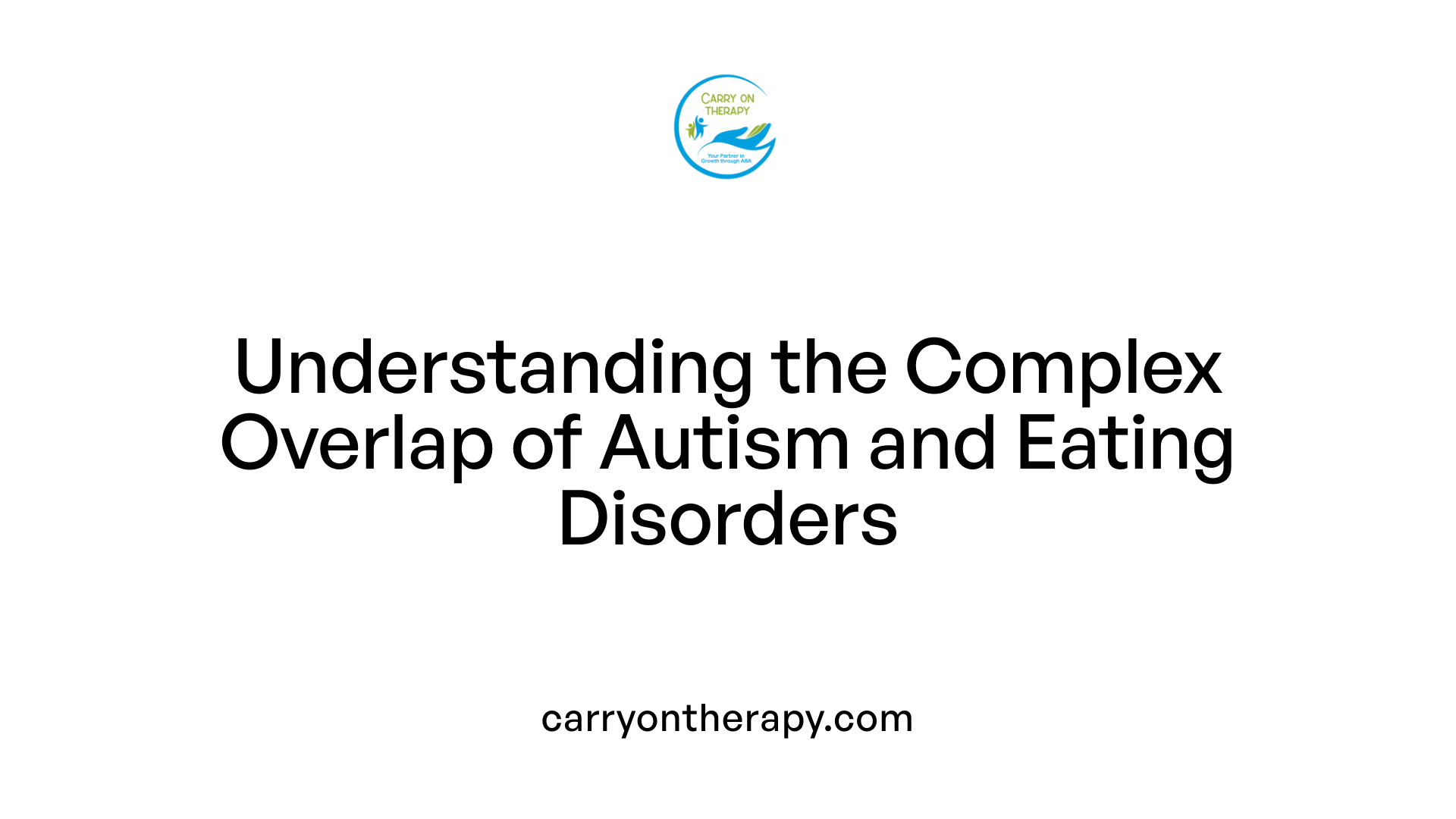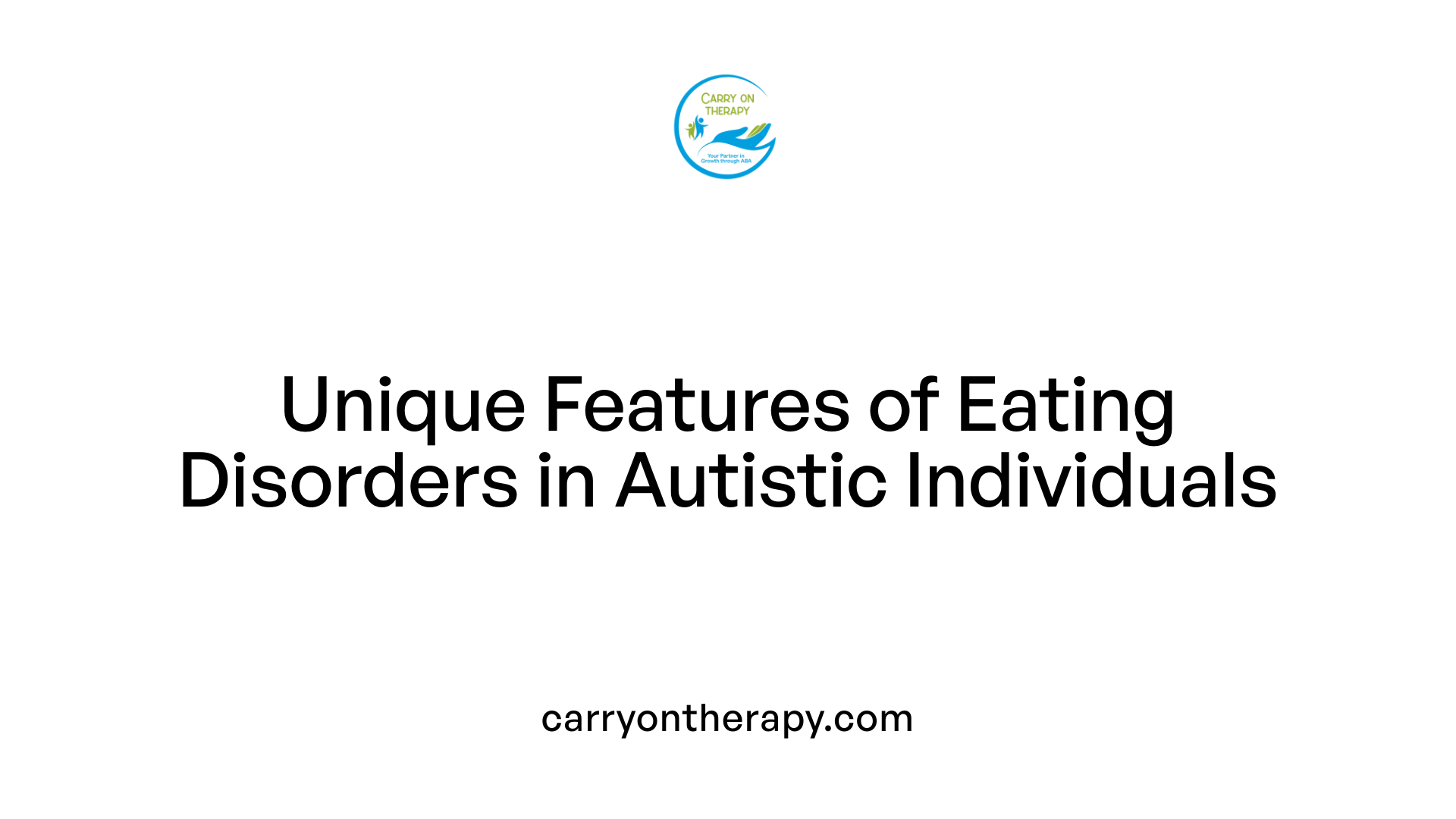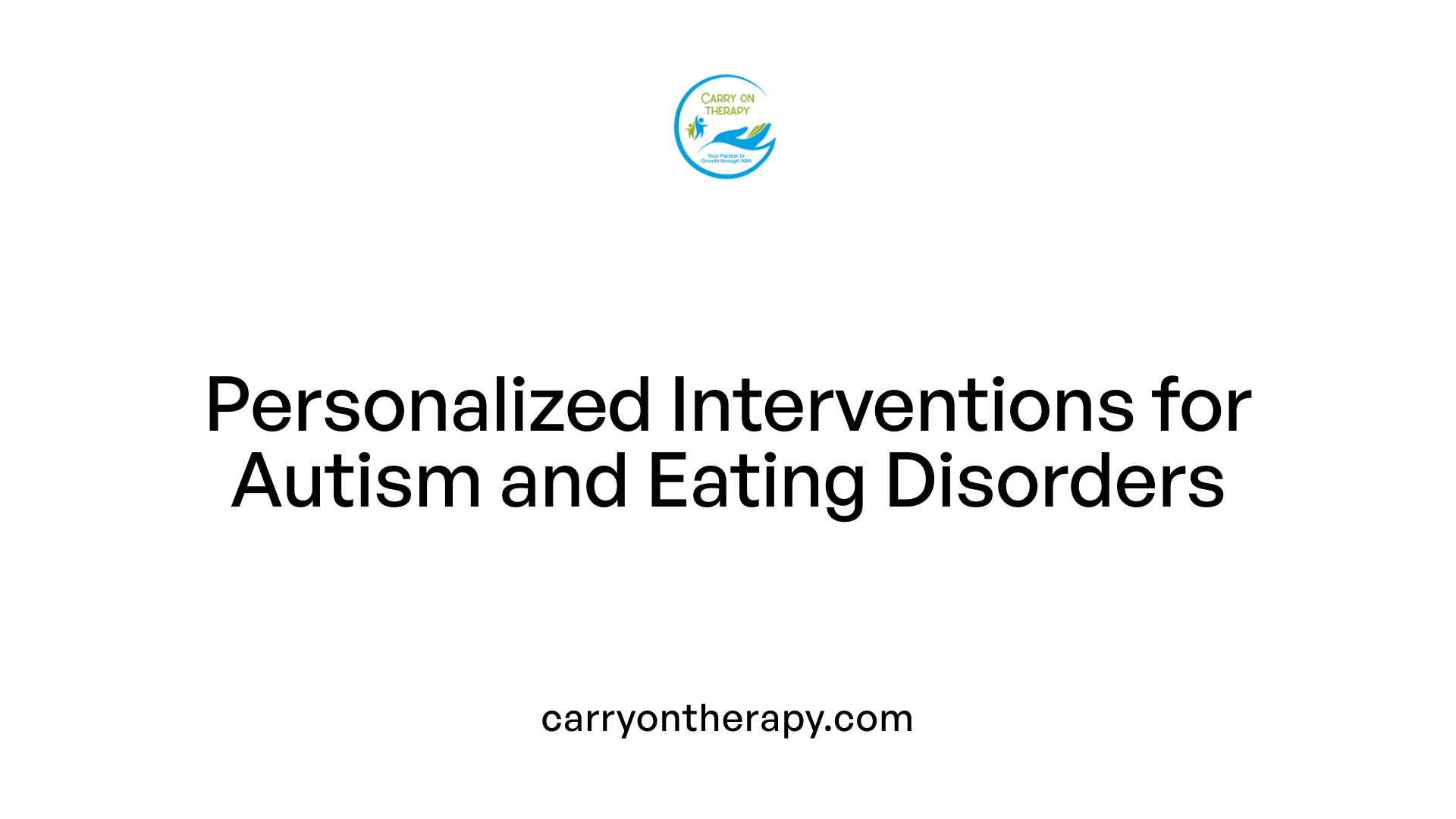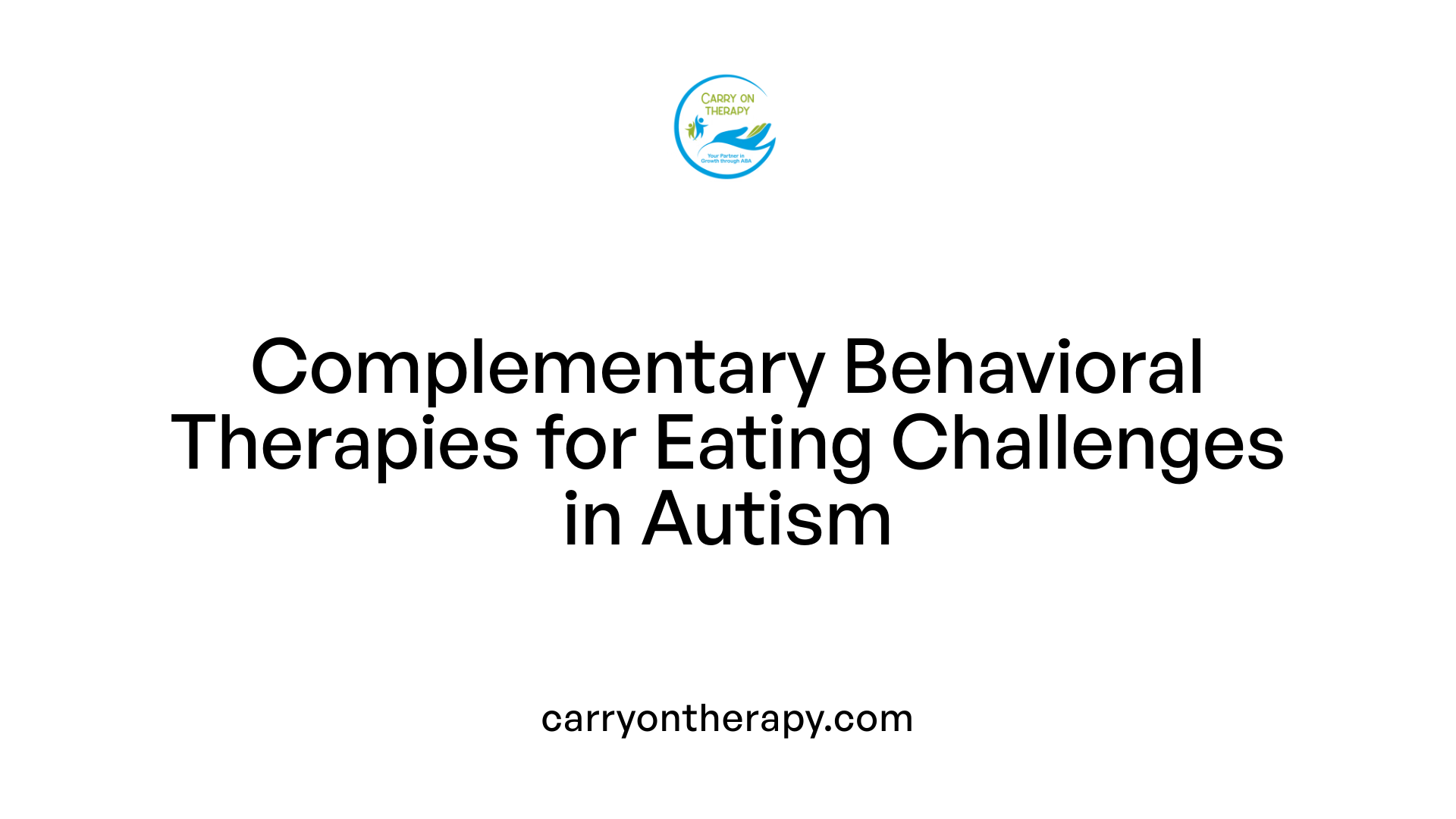Exploring the Intersection of Autism Spectrum Disorder and Eating Challenges
Autism Spectrum Disorder (ASD) and eating disorders frequently co-occur, presenting complex clinical challenges. This intersection affects diagnosis, treatment outcomes, and quality of life for individuals and their families. By unpacking the links between these conditions and exploring tailored behavioral therapies such as Applied Behavior Analysis (ABA), this article sheds light on the nuanced dynamics at play and the importance of specialized care for those affected.
Prevalence and Overlap of Autism and Eating Disorders

What is the prevalence of ASD among individuals with eating disorders?
Approximately 4.7% of patients diagnosed with eating disorders—including anorexia nervosa (AN), bulimia nervosa (BN), and binge eating disorder (BED)—also have autism spectrum disorder (ASD). This is notably higher than the ASD prevalence of around 1.7% in the general population. Among these, the highest ASD rates are observed in individuals with anorexia nervosa, with studies reporting prevalence between 10% and 29%. This elevated rate is especially pronounced in females and adolescents.
Common eating disorder subtypes in autistic individuals
Anorexia nervosa is the most frequently diagnosed eating disorder subtype among autistic individuals. In addition, autistic people with avoidant/restrictive food intake disorder (ARFID) exhibit highly restricted eating patterns, often driven by sensory sensitivities rather than weight or body image concerns. Research suggests that 20-35% of those with anorexia display elevated autistic traits or meet criteria for autism.
Rates of comorbid ASD and ADHD in individuals with eating disorders
Beyond autism, attention deficit hyperactivity disorder (ADHD) is also commonly observed in individuals with eating disorders. ADHD prevalence ranges widely from 1.6% to 18% in eating disorder populations, with particularly higher rates in binge eating/purging subtypes of AN and bulimia nervosa. Studies highlight that about 7.9% of adults with ASD and/or ADHD have current or past diagnoses of eating disorders, with anorexia more commonly linked to ASD and binge eating disorder more associated with ADHD. Females with ADHD face a notably high lifetime risk—up to 21.8%—of developing an eating disorder.
This significant overlap underscores the importance of recognizing neurodevelopmental disorders as critical factors in the understanding and treatment of eating disorders. The prevalence data suggest that screening for ASD and ADHD symptoms in eating disorder settings may improve identifying patients with complex needs and guide more tailored interventions.
Neurodevelopmental Comorbidities: ADHD and Eating Disorders

How does ADHD relate to eating disorders?
ADHD is strongly linked with various eating disorders, exhibiting prevalence rates between 1.6% and 18% among individuals with eating disorders. This association is especially pronounced in binge eating and purging subtypes of anorexia nervosa (AN) and bulimia nervosa (BN).
ADHD Prevalence in Eating Disorder Subtypes
Research reveals that ADHD occurs more frequently in patients diagnosed with binge eating/purging types of AN and BN. Girls with ADHD have more than triple the risk of developing any eating disorder compared to their peers without ADHD. Moreover, females with ADHD display up to a 21.8% lifetime prevalence of eating disorder development, highlighting a significant gender-related vulnerability.
Shared Characteristics Between ADHD and Eating Disorders
Core ADHD traits such as impulsivity and inattention overlap with clinical features of eating disorders. For example, impulsivity in ADHD contributes to behaviors like binge eating and compulsive exercising seen in bulimia nervosa and binge eating disorder. These shared behavioral patterns suggest underlying neurocognitive mechanisms common to both conditions.
Impact of ADHD on Eating Disorder Risk, Especially in Females
ADHD's influence on eating disorder risk appears particularly marked in females. The heightened vulnerability could stem from biological, psychological, and social factors interacting with ADHD symptoms. This intersection demands focused clinical attention for prevention and tailored treatment strategies in this demographic.
Neurocognitive and Symptom Overlaps Between ASD, ADHD, and Eating Disorders
What neurocognitive and behavioral features overlap between autism, ADHD, and eating disorders?
Individuals with autism spectrum disorder (ASD) and eating disorders (EDs) exhibit overlapping neurocognitive features such as weak central coherence, which relates to a focus on details over the bigger picture. They also show impaired set-shifting – difficulties with adapting to changing tasks or rules – and challenges in theory of mind, which is understanding others’ perspectives. These similarities suggest shared neurobiological mechanisms that may underpin both conditions.
Symptom overlaps between ASD and EDs include social withdrawal, rigidity in behaviors and routines, and restricted interests. These traits frequently complicate clinical presentations and can affect behavioral therapy approaches, as interventions must account for such rigidities and anxieties shared by both groups.
Attention deficit hyperactivity disorder (ADHD) also relates to several eating disorder features, particularly emphasizing impulsivity and hyperactivity. For example, individuals with ADHD often display impulsive behaviors like compulsive exercising, which overlap with ED symptoms, especially in binge eating and purging subtypes. This connection contributes to complex diagnostic challenges since impulsiveness exacerbates ED symptoms and complicates treatment.
Taken together, these overlapping neurocognitive and behavioral traits among ASD, ADHD, and EDs highlight the importance of nuanced clinical assessment. Recognizing these intersections can help clinicians tailor interventions to address both shared and unique aspects of these conditions, improving treatment outcomes across neurodiverse populations.
Mechanisms Underlying the Association Between Autism and Eating Disorders
Distinguishing artefactual versus genuine links
The relationship between autism and eating disorders (EDs) can be understood by separating artefactual from genuine associations. Artefactual associations arise due to overlapping diagnostic criteria, where symptoms of one condition may mimic or be mistaken for the other. For example, transient autistic-like traits can emerge during the course of an eating disorder, potentially leading to diagnostic confusion. Additionally, some non-specific factors may falsely inflate the perceived connection between autism and EDs.
Shared causal factors and direct influences
Genuine links between autism and eating disorders include shared underlying causes that predispose individuals to both conditions. Neurocognitive features common to autism and EDs—such as inflexible thinking, impaired set-shifting, and difficulties in social cognition—suggest overlapping neurobiological mechanisms. Autism can directly influence the development of feeding and eating disorders, with factors like sensory sensitivities and challenges in interoception (recognizing internal body signals) playing crucial roles. These sensory and regulatory differences often lead to restrictive eating behaviors that are distinct from body image concerns seen in typical anorexia nervosa presentations.
Female-specific expressions of autism through eating disorders
Emerging evidence supports the idea that some eating disorders, particularly anorexia nervosa, may represent female-specific expressions of autism. Females with autism are more frequently diagnosed with anorexia, with rates significantly exceeding those in the general population. This overlap might be due to subtler autistic traits in females that manifest primarily as atypical eating behaviors rather than classic social-communication difficulties. Recognizing these gender-related expressions is vital for developing tailored treatments that address the unique needs of autistic females with eating disorders.
Understanding these mechanisms provides a framework for improving clinical interventions. Tailoring treatments to account for sensory sensitivities, cognitive inflexibility, and gender-specific symptomatology can enhance outcomes for individuals with co-occurring autism and feeding or eating disorders.
Challenges and Unique Features of Eating Disorders in Autistic Individuals

How do eating disorders present uniquely in autistic individuals?
Eating disorders in autistic individuals manifest with distinct characteristics compared to those in neurotypical populations. A significant contributor to these differences is heightened sensory sensitivity. Many autistic people experience intense reactions to food textures, flavors, or smells, prompting highly selective eating patterns. These preferences are often rooted in sensory discomfort rather than concerns about body image, which is a common motivator in typical eating disorders.
Gastrointestinal issues further complicate the eating experience for autistic individuals. Many suffer from digestive discomforts or atypical satiety cues, which can influence both their food choices and eating habits. Difficulties with interoception—the ability to sense internal bodily signals like hunger and fullness—are prevalent and can make it challenging for them to regulate intake appropriately.
Unlike neurotypical individuals with anorexia who often focus on weight or shape concerns, autistic people with anorexia or avoidant/restrictive food intake disorder (ARFID) tend to restrict food based on sensory distress or difficulties managing emotional distress. This difference in motivation contributes to more complex treatment challenges and worse clinical outcomes. Standard therapies may be less effective if they do not address these underlying sensory and interoceptive issues.
Understanding these nuanced presentations is crucial for developing tailored interventions that accommodate sensory sensitivities and gastrointestinal complications, ultimately improving support and treatment efficacy for autistic individuals facing eating disorders.
Impact of Feeding Problems in Children with Autism on Families
Prevalence of Feeding Difficulties in Children with ASD
Feeding and eating difficulties are highly common in children with autism spectrum disorder (ASD), with around 90% experiencing some form of feeding challenge. These can include food selectivity, refusal behaviors, and poor feeding skills, making mealtimes particularly complex.
Consequences for Child Health and Development
These feeding problems can lead to significant health issues, such as nutritional deficiencies and growth delays. Gastrointestinal problems are also frequent and can affect food preferences and eating behavior. Additionally, some children exhibit abnormal satiety cues, which may contribute to excessive weight gain or obesity, compounding health concerns.
Effects on Maternal Quality of Life and Family Stress
Feeding difficulties in children with ASD have a profound impact on families, especially primary caregivers, predominantly mothers. These challenges are linked with heightened stress and psychological strain, lowering maternal quality of life. The demanding nature of managing feeding issues can disrupt parent-child interactions and increase overall family stress. Addressing these problems through evidence-based strategies like Applied Behavioral Analysis (ABA), feeding therapy, and parent training is essential not only for the child's wellbeing but also to improve familial dynamics and caregiver wellbeing.
Applied Behavior Analysis (ABA) Therapy for Autism
What is applied behavior analysis (ABA) therapy, and how does it help individuals with autism?
Applied behavior analysis (ABA) therapy is a scientifically validated approach that focuses on improving social, communication, and learning skills in people with autism. It works by breaking down complex tasks into smaller, manageable steps and systematically encouraging positive behaviors using reinforcement techniques.
Definition and principles of ABA
ABA uses the principles of behaviorism to modify behaviors, focusing on increasing helpful actions and reducing those that interfere with learning or social functioning. The therapy relies on repeated practice, data collection, and ongoing evaluation to optimize outcomes.
How ABA improves skills in autism
The therapy targets areas such as language, social interaction, and self-care, helping individuals develop new skills while decreasing challenges like repetitive behaviors. Positive reinforcement, such as praise or rewards, motivates individuals to continue practicing desired behaviors, fostering progress in various domains.
Individualization and positive reinforcement
ABA programs are highly individualized, tailored to each person's abilities, preferences, and goals. Qualified behavior analysts design these plans to meet specific needs, ensuring that interventions are meaningful and effective. Positive reinforcement is central to ABA, encouraging skill acquisition and maintaining motivation over time.
Overall, ABA therapy offers structured, evidence-based support that can significantly enhance daily functioning and quality of life for individuals on the autism spectrum.
Providers and Delivery Settings of ABA Therapy
Who typically provides ABA therapy?
ABA therapy is commonly delivered by Board Certified Behavior Analysts (BCBAs), who are highly trained professionals responsible for designing and overseeing personalized intervention plans. They assess individual needs and develop strategies to address behavioral challenges.
Registered Behavior Technicians (RBTs) work under the supervision of BCBAs and carry out the daily therapeutic activities with clients. These trained therapists play a critical role in applying the specific techniques and collecting data to monitor progress.
Family involvement is fundamental to the success of ABA therapy. Caregivers and parents actively participate by practicing learned strategies at home, reinforcing skills, and providing valuable feedback to therapists.
ABA therapy is versatile in its delivery environments. It can take place in clinical settings where specialized equipment and resources are available, in clients' homes to provide personalized and familiar contexts, or within schools to support educational goals and social integration.
This multi-setting approach ensures that interventions are consistent and tailored to the individual's natural environments, enhancing generalization and effectiveness of therapeutic outcomes.
Core Behavioral Principles Underpinning Autism Therapy
What are the key principles behind behavioral analysis used in autism therapy?
Behavioral analysis in autism therapy is a scientific approach focusing on enhancing helpful behaviors while minimizing those that interfere with daily functioning. Central to this method is positive reinforcement, which rewards desirable behaviors to encourage their recurrence.
Therapists carefully observe the antecedents (events before a behavior) and consequences (events following a behavior) to understand how behaviors are maintained or changed. This systematic observation helps in developing strategies that effectively modify behaviors.
Data collection plays a crucial role. Therapists gather detailed information on behaviors over time to monitor progress and adjust interventions accordingly. This data-driven approach ensures that therapy remains individualized and responsive to each person's unique needs.
Several techniques are employed within behavioral analysis:
- Discrete Trial Training (DTT): This structured method involves breaking down skills into small steps, teaching them one at a time, often in a controlled environment.
- Modeling: Demonstrating desired behaviors for the individual to imitate.
- Shaping: Gradually guiding behaviors toward a target by reinforcing successive approximations.
- Naturalistic Interventions: Techniques like pivotal response treatment focus on teaching skills within natural settings and using child-led activities to increase motivation.
The combination of these approaches aims to improve communication, social interaction, and daily living skills in autistic individuals. Importantly, behavioral therapy is tailored to suit individual strengths and challenges and is delivered by trained professionals committed to evidence-based best practices.
Expected Outcomes and Progress from ABA Therapy
What kind of progress can families expect from ABA therapy for autism?
Families engaging in Applied Behavioral Analysis (ABA) therapy for autism can anticipate notable improvements in several essential areas. ABA therapy aims to enhance communication skills, enabling children to express needs and interact more effectively with others.
Social skill development is another major benefit. Children often learn to better understand social cues, participate in group activities, and build peer relationships, leading to increased social integration.
Adaptive behavior improvements are frequently observed. Children gain competence in daily activities such as dressing, toileting, and managing emotions. These functional skills directly contribute to greater independence and quality of life.
The extent of progress varies and depends on important factors. Early intervention and intensive ABA therapy typically yield the most significant gains. Family involvement and consistent application of therapeutic techniques at home and school reinforce learning and behavioral changes.
Overall, ABA therapy can lead to meaningful development in communication, social interaction, and adaptive functioning, empowering children with autism to reach their full potential and easing family caregiving challenges.
Tailoring Clinical Interventions for Autism and Eating Disorders

How can clinical interventions be tailored for individuals with comorbid autism and eating disorders?
Clinical interventions for individuals with both autism and eating disorders must move beyond conventional treatment frameworks. Neurodiversity-affirming care is essential, which means validating autistic traits and supporting the individual's self-determination throughout treatment. This approach recognizes and respects neurodivergent experiences rather than trying to fit everyone into a neurotypical mold.
Need for neurodiversity-affirming care
Standard eating disorder therapies often rely on assumptions based on neurotypical cognition and emotional processing. Such neuronormative approaches can be inadequate or even harmful for autistic individuals, as they may not address core autistic needs or may overlook sensory and communication differences. Incorporating neurodiversity-affirming principles ensures that treatments honor the unique ways autistic individuals perceive and interact with the world.
Importance of sensory and emotional accommodations
Many autistic people face sensory sensitivities that influence food preferences and eating behaviors. Effective clinical treatment must tailor interventions to these sensory issues, for example, by incorporating sensory-based supports and modifying eating environments to reduce distress. Emotional processing differences, including difficulties with interoception (awareness of internal body signals like hunger and fullness) and alexithymia (trouble recognizing emotions), also warrant specialized support. Therapies that include cognitive remediation and exposure techniques tailored to sensory sensitivities can help address rigid patterns and anxiety around food.
Limitations of neuronormative treatment approaches
Conventional treatments for eating disorders often do not accommodate executive functioning challenges common in autism, such as cognitive inflexibility and difficulties with task initiation. Without adaptations, interventions may fail to engage autistic individuals effectively or improve outcomes. Recognizing these limitations encourages the use of frameworks like SPACE and sensory-based therapies, which offer more personalized and effective methods.
Integrating these tailored strategies leads to improved clinical outcomes, reducing the risk of poor treatment response seen in autistic individuals with eating disorders when they receive standard care. This approach promotes recovery by addressing the complex interplay of neurodevelopmental and eating disorder-related challenges comprehensively.
Behavioral Therapies Complementing ABA to Address Eating Issues

Use of Exposure and Response Prevention (ERP)
Exposure and Response Prevention (ERP) is an effective behavioral therapy particularly useful for feeding and eating disorders that co-occur with autism. ERP involves gradually exposing individuals to anxiety-provoking foods or situations without allowing them to engage in their typical avoidance or compulsive behaviors. This method is especially beneficial for conditions such as Avoidant/Restrictive Food Intake Disorder (ARFID), where sensory sensitivities or distress around specific foods cause highly restricted eating patterns. By implementing ERP, patients can reduce food-related anxieties and increase food acceptance.
Cognitive Remediation Therapy (CRT) Roles
Cognitive Remediation Therapy (CRT) aims to improve cognitive flexibility, planning, and problem-solving skills, which are often impaired in individuals with neurodevelopmental disorders and eating difficulties. In autism and eating disorder populations, CRT can help reduce rigid thinking and obsessive behaviors that interfere with healthy eating patterns. It supports better daily functioning by addressing challenges such as weak central coherence and impaired set-shifting, traits shared by autism spectrum disorder and eating disorders like anorexia nervosa.
Applied Behavioral Strategies for Feeding Difficulties
Alongside ERP and CRT, Applied Behavioral Analysis (ABA) remains a cornerstone therapy to manage feeding difficulties in autistic individuals. ABA focuses on structured interventions and skill-building to improve feeding behaviors, reduce food refusal, and address sensory-related challenges. Included are parent-training components that empower caregivers to support feeding progress effectively. Feeding therapy often combines ABA with multidisciplinary collaboration involving special education teachers, psychologists, and nurses, improving outcomes not only for the individual but also maternal quality of life, which can be significantly impacted by feeding problems.
Together, these behavioral therapies complement each other by addressing different aspects of eating issues in autism. They provide tailored approaches that recognize sensory sensitivities, cognitive challenges, and anxiety components, leading to more effective support and improved clinical outcomes.
Moving Forward: Integrating Knowledge and Therapy for Better Outcomes
The intricate relationship between autism and eating disorders demands comprehensive understanding and specialized clinical approaches. Recognizing the unique challenges autistic individuals face during assessment and treatment is essential to formulating effective interventions. Applied behavior analysis remains a cornerstone therapy for developing critical skills, while additional behavioral methods like exposure therapy and cognitive remediation offer promise for addressing eating-related challenges. Supporting families and embracing neurodiversity-affirming care models can improve treatment outcomes and quality of life for those affected, highlighting a path toward more personalized, empathetic support in this complex intersection.
References
- Potential mechanisms underlying the association between ...
- Systematic Review: Overlap Between Eating, Autism ...
- Systematic Review: Overlap Between Eating, Autism ...
- Eating, eating disorders and autism | What is autism?
- Understanding the Link Between Eating Disorders, Autism ...
- The relationship between the eating behaviors and ...
- Neurodivergence, intersectionality, and eating disorders
- Applied Behavior Analysis (ABA)
- The Top 10 Reasons Children With Autism Deserve ABA
You have to Start to be Great!






